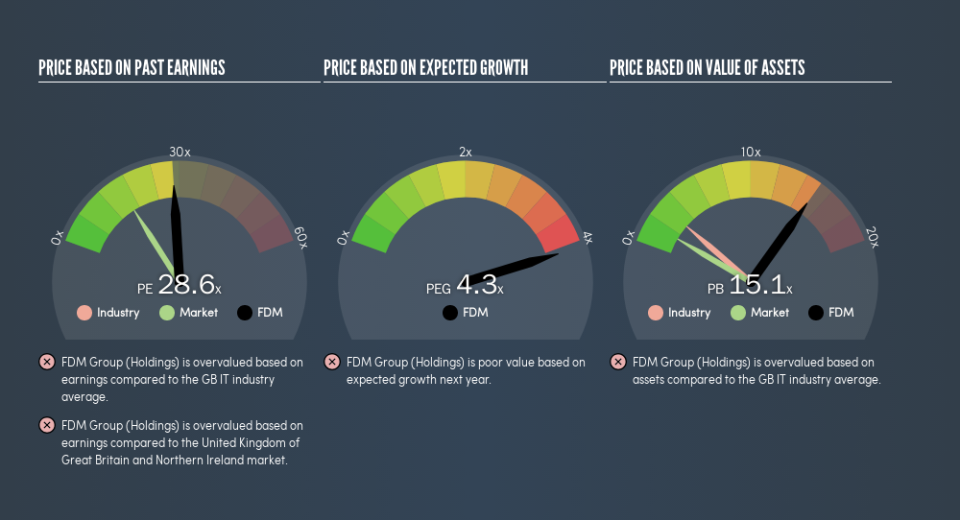What Does FDM Group (Holdings) plc's (LON:FDM) P/E Ratio Tell You?

Want to participate in a short research study? Help shape the future of investing tools and you could win a $250 gift card!
This article is for investors who would like to improve their understanding of price to earnings ratios (P/E ratios). We'll look at FDM Group (Holdings) plc's (LON:FDM) P/E ratio and reflect on what it tells us about the company's share price. FDM Group (Holdings) has a P/E ratio of 28.55, based on the last twelve months. In other words, at today's prices, investors are paying £28.55 for every £1 in prior year profit.
Check out our latest analysis for FDM Group (Holdings)
How Do You Calculate A P/E Ratio?
The formula for P/E is:
Price to Earnings Ratio = Share Price ÷ Earnings per Share (EPS)
Or for FDM Group (Holdings):
P/E of 28.55 = £9.8 ÷ £0.34 (Based on the year to December 2018.)
Is A High Price-to-Earnings Ratio Good?
A higher P/E ratio implies that investors pay a higher price for the earning power of the business. That isn't a good or a bad thing on its own, but a high P/E means that buyers have a higher opinion of the business's prospects, relative to stocks with a lower P/E.
How Growth Rates Impact P/E Ratios
Earnings growth rates have a big influence on P/E ratios. That's because companies that grow earnings per share quickly will rapidly increase the 'E' in the equation. Therefore, even if you pay a high multiple of earnings now, that multiple will become lower in the future. So while a stock may look expensive based on past earnings, it could be cheap based on future earnings.
FDM Group (Holdings) increased earnings per share by an impressive 15% over the last twelve months. And it has bolstered its earnings per share by 20% per year over the last five years. So one might expect an above average P/E ratio.
How Does FDM Group (Holdings)'s P/E Ratio Compare To Its Peers?
The P/E ratio essentially measures market expectations of a company. The image below shows that FDM Group (Holdings) has a P/E ratio that is roughly in line with the it industry average (28.6).
Its P/E ratio suggests that FDM Group (Holdings) shareholders think that in the future it will perform about the same as other companies in its industry classification. If the company has better than average prospects, then the market might be underestimating it. Further research into factors such asmanagement tenure, could help you form your own view on whether that is likely.
Don't Forget: The P/E Does Not Account For Debt or Bank Deposits
Don't forget that the P/E ratio considers market capitalization. So it won't reflect the advantage of cash, or disadvantage of debt. Hypothetically, a company could reduce its future P/E ratio by spending its cash (or taking on debt) to achieve higher earnings.
Such expenditure might be good or bad, in the long term, but the point here is that the balance sheet is not reflected by this ratio.
How Does FDM Group (Holdings)'s Debt Impact Its P/E Ratio?
The extra options and safety that comes with FDM Group (Holdings)'s UK£34m net cash position means that it deserves a higher P/E than it would if it had a lot of net debt.
The Verdict On FDM Group (Holdings)'s P/E Ratio
FDM Group (Holdings) trades on a P/E ratio of 28.6, which is above the GB market average of 16.1. Its strong balance sheet gives the company plenty of resources for extra growth, and it has already proven it can grow. So it is not surprising the market is probably extrapolating recent growth well into the future, reflected in the relatively high P/E ratio.
Investors have an opportunity when market expectations about a stock are wrong. If the reality for a company is better than it expects, you can make money by buying and holding for the long term. So this free report on the analyst consensus forecasts could help you make a master move on this stock.
Of course you might be able to find a better stock than FDM Group (Holdings). So you may wish to see this free collection of other companies that have grown earnings strongly.
We aim to bring you long-term focused research analysis driven by fundamental data. Note that our analysis may not factor in the latest price-sensitive company announcements or qualitative material.
If you spot an error that warrants correction, please contact the editor at editorial-team@simplywallst.com. This article by Simply Wall St is general in nature. It does not constitute a recommendation to buy or sell any stock, and does not take account of your objectives, or your financial situation. Simply Wall St has no position in the stocks mentioned. Thank you for reading.


